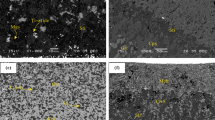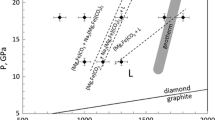Abstract
We have experimentally investigated the phase and melting relations of garnet + clinopyroxene + carbonate assemblages at 2.5–5.5 GPa, to assess the feasibility of carbonated eclogite as a source for some crustally emplaced carbonatites. The solidus of our composition was at ≈1,125 °C at 2.5 GPa, ≈1,225 °C at 3.5 GPa and ≈1,310 °C at 5.0 GPa. Melts were sodic calcio-dolomitic carbonatites, and were markedly more calcic than the dolomitic melts produced by partial melting of carbonated peridotite. Na contents of the experimental carbonatites decreased with increasing pressure when compared at similar degrees of melting, and SiO2 contents increased with degree of melting. Experiments on a second composition with enhanced Na2O demonstrated its strong effect in lowering melting temperatures in carbonate eclogite. Natural carbonated eclogite bodies in the peridotitic upper mantle will have a range of solidus temperatures. In many cases, carbonate will be molten in the upper ≥250 km. Carbonate melt would segregate from its source eclogite at very low melt fractions and infiltrate surrounding peridotitic wall rock. This would result in metasomatic enrichment of the peridotitic wall rock, but its exact nature will depend on the relative P–T positions of the eclogite + CO2 and peridotite + CO2 solidii. As a result of these inevitable metasomatic interactions, it is considered unlikely that carbonatite melts derived from carbonated eclogite in the upper mantle could be emplaced into the crust unmodified. However, they may have a role in metasomatically enriching and carbonating parts of the upper mantle, producing sources suitable for subsequent production of silica undersaturated silicate liquids and carbonatites ultimately emplaced in the crust.









Similar content being viewed by others
References
Allègre CJ, Turcotte DL (1986) Implications of a two-component marble-cake mantle. Nature 323:123–127
Alt JC, Teagle DAH (1999) The uptake of carbon during alteration of ocean crust. Geochim Cosmochim Acta 63:1527–1535
Alt JC, Honnorez J, Laverne C, Emmermann R (1986) Hydrothermal alteration of a 1 km section through the upper oceanic crust, deep sea drilling project hole 504B: mineralogy, chemistry and evolution of sea-water basalt interactions. J Geophys Res 91:10309–10335
Baragar WRA, Plant AG, Pringle GJ, Schau M (1977) Petrology and alteration of selected units of Mid-Atlantic Ridge basalts samples from sites 332 and 335, DSDP. Can J Earth Sci 14:837–874
Bell K (2001) Carbonatites: relationships to mantle plume activity. Geol Soc Am Spec Paper 352:267–290
Bell K, Tilton GR (2001) Nd, Pb and Sr isotopic compositions of East African carbonatites: evidence for mantle mixing and plume inhomogeneity. J Petrol 42:1927–1945
Bell K, Blenkinson J, Cole J, Menagh DP (1982) Evidence from Sr isotopes for long-lived heterogeneities in the upper mantle. Nature 298:251–253
Bose K, Ganguly J (1995) Quartz–coesite transition revisited: reversed experimental determination at 500–1,200 °C and retrieved thermochemical properties. Am Mineral 80:231–238
Brey G, Brice WR, Ellis DJ, Green DH, Harris KL, Ryabchikov ID (1983) Pyroxene–carbonate reactions in the upper mantle. Earth Planet Sci Lett 62:63–74
Brey GP, Weber R, Nickel KG (1990) Calibration of a belt apparatus to 1,800 °C and 6 GPa. J Geophys Res 95:603–615
Byrnes AP, Wyllie PJ (1981) Subsolidus and melting relations for the join CaCO3–MgCO3 at 10 kb. Geochim Cosmochim Acta 45:321–328
Christensen UR, Hofmann AW (1994) Segregation of subducted oceanic crust in the convecting mantle. J Geophys Res 99:19867–19884
Dalton JA, Prenall DC (1998) Carbonatitic melts along the solidus of model lherzolite in the system CaO–MgO–Al2O3–SiO2–CO2 from 3 to 7 GPa. Contrib Mineral Petrol 131:123–135
Dalton JA, Wood BJ (1993) The compositions of primary carbonate melts and their evolution through wallrock reaction in the mantle. Earth Planet Sci Lett 119:511–525
Deines P (1989) Stable isotope variations in carbonatites. In: Bell, K (ed) Carbonatites: genesis and evolution. Unwin Hyman, London, pp 301–359
Ellis DJ, Green DH (1979) An experimental study of the effect of Ca upon garnet–clinopyroxene Fe–Mg exchange equilibria. Contrib Mineral Petrol 71:13–22
Falloon TJ, Green DH (1989) The solidus of carbonated, fertile peridotite. Earth Planet Sci Lett 94:364–370
Falloon TJ, Green DH (1990) Solidus of carbonated fertile peridotite under fluid-saturated conditions. Geology 18:195–199
Green DH, Falloon TJ, Eggins SM, Yaxley GM (2001) Primary magmas and mantle temperatures. Eur J Mineral 13:437–451
Hart SR, Staudigel H (1978) Oceanic crust: age of hydrothermal alteration. Geophys Res Lett 5:1009–1012
Hauri EH, Hart SR (1993) Re–Os isotope systematics of HIMU and EMII oceanic islands from the south Pacific Ocean. Earth Planet Sci Lett 114:353–371
Hauri EH, Shimuzu N, Dieu JJ, Hart SR (1993) Evidence for hotspot-related carbonatite metasomatism in the oceanic upper mantle. Nature 365:221–227
Hermann J, Rubatto D, Korsakov A, Shatsky VS (2001) Multiple zircon growth during fast exhumation of diamondiferous, deeply subducted continental crust (Kokchetav Massif, Kazakhstan). Contrib Mineral Petrol 141:66–82
Hoernle K, Tilton GR, Le Bas MJ, Duggen S, Garbe-Schönberg D (2002) Geochemistry of oceanic carbonatites compared with continental carbonatites: mantle recycling of oceanic crustal carbonate. Contrib Mineral Petrol 142:520–542
Hofmann AW (1997) Mantle geochemistry: the message from oceanic volcanism. Nature 385:219–229
Hofmann AW, White WM (1982) Mantle plumes from ancient oceanic crust. Earth Planet Sci Lett 57:421–436
Hunter RH, McKenzie D (1989) The equilibrium geometry of carbonate melts in rocks of mantle composition. Earth Planet Sci Lett 92:347–356
Irving A, Wyllie P (1975) Subsolidus and melting relationships for calcite, magnesite and the join CaCO3–MgCO3 to 36 kb. Geochim Cosmochim Acta 39:35–53
Jago BC, Gittins J (1991) The role of fluorine in carbonatite magma evolution. Nature 349:56–58
Kerrick DM, Connolly JAD (2001) Metamorphic devolatilization of subducted oceanic metabasalts: implications for seismicity, arc magmatism and volatile recycling. Earth Planet Sci Lett 189:19–29
Kjarsgaard BA, Hamilton DL (1988) Liquid immiscibility and the origin of alkali-poor carbonatites. Mineral Mag 52:43–55
Kjaarsgaard BA, Hamilton DL (1989) Carbonatite origin and diversity. Nature 338:547–548
Kogiso T, Tatsumi Y, Shimoda G, Barsczus HG (1997) High µ (HIMU) oceanic island basalts in southern Polynesia: new evidence for whole mantle scale recycling of subducted oceanic crust. J Geophys Res 102:8085–8103
Koster van Groos AF, Wyllie PJ (1973) Liquid immiscibility in the join NaAlSi3O8–CaAl2Si2O8–Na2CO3–H2O. Am J Sci 273:465–487
Kwon S-T, Tilton GR, Grünenfelder MH (1989) Lead isotope relationships in carbonatites and alkalic complexes: an overview. In: Bell K (ed) Carbonatites: genesis and evolution. Unwin Hyman, London, pp 360–387
Lassiter JC, Hauri EH (1998) Osmium isotope variations in Hawaiian lavas: evidence for recycled oceanic lithosphere in the Hawaiian plume. Earth Planet Sci Lett 164:483–496
Lee W-J, Wyllie PJ (1996) Liquid immiscibility in the join NaAlSi3O8–CaCO3 to 2.5 GPa and the origin of calciocarbonatite magmas. J Petrol 37:1125–1152
Lee W-J, Wyllie PJ (1997a) Liquid immiscibility between nephelinite and carbonatite from 1.0 to 2.5 GPa compared with mantle melt compositions. Contrib Mineral Petrol 127:1-16
Lee W-J, Wyllie PJ (1997b) Liquid immiscibility in the join NaAlSiO4–NaAlSi3O8–CaCO3 at 1 GPa: implications for crustal carbonatites. J Petrol 38:1113–1135
Luth RW (1993) Diamonds, eclogites, and the oxidation state of the Earth’s mantle. Science 261:66–68
Luth RW (1995) Experimental determination of the reaction dolomite + 2 coesite = diopside + 2 CO2 to 6 GPa. Contrib Mineral Petrol 122:152–158
Luth RW (2001) Experimental determination of the reaction aragonite + magnesite = dolomite at 5 to 9 GPa. Contrib Mineral Petrol 141:222–232
McKenzie D, Bickle MJ (1988) The volume and composition of melt generated by extension of the lithosphere. J Petrol 29:625–679
Minarik WG, Watson EB (1995) Interconnectivity of carbonate melt at low melt fraction. Earth Planet Sci Lett 133:423–437
Molina JF, Poli S (2000) Carbonate stability and fluid composition in subducted oceanic crust: an experimental study on H2O–CO2-bearing basalts. Earth Planet Sci Lett 176:295–310
Nelson DR, Chivas AR, Chappell BW, McCulloch MT (1988) Geochemical and isotopic systematics in carbonatites and implications for the evolution of ocean-island sources. Geochim Cosmochim Acta 52:1–17
Otto JW, Wyllie PJ (1993) Relationships between silicate melts and carbonate-precipitating melt in CaO–MgO–SiO2–CO2–H2O at 2 kbar. Mineral Petrol 48:343–365
Richardson SH, Hart SR, Staudigel H (1980) Vein mineral ages of old oceanic crust. J Geophys Res 85:7195–7200
Rudnick RL, McDonough WF, Chappell BW (1993) Carbonatite metasomatism in the northern Tanzanian mantle: petrographic and geochemical characteristics. Earth Planet Sci Lett 114:463–476
Sweeney RJ (1994) Carbonatite melt compositions in the Earth’s mantle. Earth Planet Sci Lett 128:259–270
Thibault Y, Edgar AD, Lloyd FE (1992) Experimental investigation of melts from a carbonated phlogopite lherzolite: implications for metasomatism in the continental lithospheric mantle. Am Mineral 77:784–794
Tilton GR, Bell K (1994) Sr–Nd–Pb isotope relationships in late Archean carbonatites and alkaline complexes: applications to the geochemical evolution of the mantle. Geochim Cosmochim Acta 58:578–583
Treiman AH (1989) Carbonatite magmas: properties and processes. In: Bell K (ed) Carbonatites: genesis and evolution. Unwin Hyman, London, pp 89–104
Treiman AH, Essene EJ (1983) Mantle eclogite and carbonate as sources of sodic carbonatites and alkalic magmas. Nature 302:700–703
Veksler IV, Nielsen TFD, Sokolov SV (1998) Mineralogy of crystallized melt inclusions from Gardiner and Kovdor ultramafic alkaline complexes: implications for carbonatite petrogenesis. J Petrol 39:2015–2031
Wallace M, Green DH (1988) An experimental determination of primary carbonatite composition. Nature 335:343–345
Wyllie PJ, Huang W-L (1975) Influence of mantle CO2 in the generation of carbonatites and kimberlites. Nature 257:297–299
Wyllie P, Huang W-L (1976) Carbonation and melting reactions in the system CaO–MgO–SiO2–CO2 at mantle pressures with geophysical and petrological applications. Contrib Mineral Petrol 54:79–107
Yaxley GM (1999) Phase relations of carbonated eclogite under upper mantle PT conditions — implications for carbonatite petrogenesis. Proceedings of the 7th International Kimberlite Conference, Cape Town, vol 2, pp 933–939
Yaxley GM, Green DH (1994) Experimental demonstration of refractory carbonate-bearing eclogite and siliceous melt in the subduction regime. Earth Planet Sci Lett 128:313–325
Yaxley GM, Crawford AJ, Green DH (1991) Evidence for carbonatite metasomatism in spinel peridotite xenoliths from western Victoria, Australia. Earth Planet Sci Lett 107:305–317
Yaxley GM, Green DH, Klápová H (1994) The refractory nature of carbonate during partial melting of eclogite: evidence from high pressure experiments and natural carbonate-bearing eclogites. Mineral Mag 58A:996–997
Acknowledgements
We gratefully acknowledge the assistance of Thomas Kautz, Daniel Röhnert and Vadim Bulatov (Universität Frankfurt), and Bill Hibberson (ANU) with the experiments, Jan Heliosch (Universität Frankfurt) with sample preparation, and Frank Brink (ANU) with the electron microscopy. This study benefited from discussions with David Green, Jörg Hermann, Andrei Girnis and Thomas Stachel, and the manuscript was improved by careful and constructive reviews from Stephen Foley and Stefano Poli. This project was supported by the Alexander von Humboldt Foundation (GMY), the Deutsche Forschungsgemeinschaft (GPB) and the Australian Research Council (GMY).
Author information
Authors and Affiliations
Corresponding author
Additional information
Editorial responsibility: J. Hoefs
Rights and permissions
About this article
Cite this article
Yaxley, G.M., Brey, G.P. Phase relations of carbonate-bearing eclogite assemblages from 2.5 to 5.5 GPa: implications for petrogenesis of carbonatites. Contrib Mineral Petrol 146, 606–619 (2004). https://doi.org/10.1007/s00410-003-0517-3
Received:
Accepted:
Published:
Issue Date:
DOI: https://doi.org/10.1007/s00410-003-0517-3




